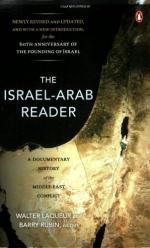|
This section contains 546 words (approx. 2 pages at 400 words per page) |

|
Part IV, pp. 258-303 Summary and Analysis
Hassanain Haykal views the conflict as a way of forcing the Arab nations to submit to the domination of the West. The 1967 cease-fire lines will be a source of continued conflict. Haykal analyzes the war and concludes that there were many high level Arab shortcomings. Israel did not want to enter the war. As long as Israel has greater military strength than the Arabs, the United States will not be in a hurry to find a solution to the problem. It is through the military strength and intimidation of the Arabs by Israel that the United States dominates the Middle East. In terms of 1967, Israel wins the battle but the war will continue and future wars will be different because the Israelis will be forced to use different tactics because they will involve densely populated...
(read more from the Part IV, pp. 258-303 Summary)
|
This section contains 546 words (approx. 2 pages at 400 words per page) |

|




